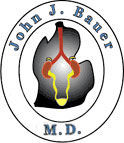
www.flinturology.com
Urology Services, Inc.
G-1121 West Hill Rd.
Flint, Michigan 48507
Tel: 810.232.8888
Fax: 810.232.9190
Email: jbauer@flinturology.com
[map]
 |
John J. Bauer, M.D.
www.flinturology.com Urology Services, Inc.
|
Patient Name:
Age:
Date:
Procedure: Male sling, cystoscopy, trocar cystotomy tube placement
Indications:
Patient is a male with stress urinary incontinence from previous prostate surgery for benign and malignant conditions or has an incompetent sphincter secondary to neurological disease. Urodynamic studies have confirmed the presence of Type III stress urinary incontinence with a low valsalva leak point pressure. The procedure requires the placement of a suprapubic cystotomy tube under cystoscopic guidance for urinary drainage.
Alternatives:
Alternatives include watchful waiting, Kegel exercises, behavioral/biofeedback/electrical stimulation therapy, injection of urethral bulking agents and an artificial urinary sphincter (AUS-800).
Risks/Complications:
The risks and complications of the procedure where extensively discussed with the patient. The general risks of this procedure include, but are not limited to bleeding, transfusion, infection, wound infection/dehiscence, pain, scaring of tissues, failure of the procedure, potential injury to other surrounding structures, deep venous thrombosis, pulmonary embolus, myocardial infarction, heart failure, stroke, death or a long-term stay in the Intensive Care Unit (ICU). Additionally, mentioned were the possible serious complications of the anesthesia to include cracked teeth, airway damage, aspiration, pneumonia, spinal head-ache, nerve damage, spinal canal bleeding and malignant hyperthermia. Your anesthesiologist will discuss the risks and complications in more depth separately. Additional procedures may be necessary.
The specific risks of this procedure include, but are not limited to: persistent incontinence, late failure of the sling with resultant incontinence, further therapy with bulking agents or AUS-800, if bone anchors are used then chronic pain or infection that may require removal of the anchors, chronic penile pain, numbness or hyperasthetic scrotal/perineal skin, the procedure uses non-absorbable mesh that can be infected in the future, will require prophylactic antibiotics before other surgical and dental procedures to avoid possible seeding of the mesh with bacteria, if the mesh does get infected then long- term antibiotics or removal of the mesh may be necessary. This procedure is a relatively new procedure and does not have any long term data regarding the results. Current results show 50% dry rate, total 87% dry or improved rate (~ 2 pads/day) at 6 months. A cystoscopy will be required for placement of a trocar cystotomy tube and to make sure that sutures where not inadvertently placed through the bladder, the trocar may pass through intestines and once diagnosed requiring further surgical procedures to correct the bowel injury possibly including a bowel diversion and external appliance for an extended period of time. Reconnection of the bowel segments will then be required at a later date.
You understand the procedure, general and specific risks as discussed and agree to proceed with the procedure. You also understand that not every possible complication can be listed in this counseling note and additional risks are possible, although unlikely.
Physician's Signature: ________________________________ Date: __________________
Patient Signature: __________________________________ Date: __________________
Witness: __________________________________